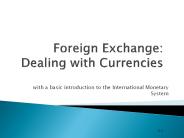Foreign Exchange System - PowerPoint PPT Presentation
1 / 10
Title:
Foreign Exchange System
Description:
(ability to correct the problem by itself) Trade Trade. deficit Gold Ms Price Export Balance ... devaluate $ by increasing supply of $ (= buy FX ) ... – PowerPoint PPT presentation
Number of Views:30
Avg rating:3.0/5.0
Title: Foreign Exchange System
1
- Foreign Exchange System
- 1) Gold Standard System
- a. Ex. rate pegged to a certain of gold.
- b. Gold convertibility maintained.
- (
) - Advantage
- a. Stability in F.X. system.
- b. Built-in adjustment mechanism.
- (ability to correct the problem by
itself) - Trade
Trade - deficit Gold Ms Price Export
Balance - Disadvantage
2
- 2) Flexible (Floating) Exchange System
- Money was supplied w/o any linkage
- to gold ex. rate was solely decided
- by ( ).
- Demand for Y U.S. demand for Japanese
product - Supply of Y Japanese demand for U.S
product - Adv
- a.
- b.
- Disadv.
- a.
- b.
- World trade didnt increase!
Y
S
D
3
- 3) Fixed Ex. (Bretton Woods) System
- a. all currencies were pegged to and
was pegged to - gold.
- b. obligated to maintain their ex. rates
with respect to - within ( ) margin.
- Adv. relatively stable.
- Disad a. a large of FX will be needed to
defend fixed rate. - BOP deficit will put a pressure
on them to - ( ) their
currencies. To defend the fixed rate - under this pressure, they need
to create an - artificial demand for their own
currency - (how?
). - This means they have to pay in FX
( ) and - that will make them to lose even
more FX. - b. When they run out of FX, there
will be a chaos.
4
- Other problems under Bretton Woods System
- A. Shortage of international money
- a.
- b.
- B. Mistrust of
- a.
- b.
- Jamaica Agreement (1976)
- a. abolished Bretton Woods System
- b. each country selected its own F.X. system
- c. all kind of variations concurrently
exist.
5
- Exchange-rate Regimes (IMF)
- No legal tender use other countrys currency or
share common - currency among the monetary union ( El
Salvador, EU, CFC). - 2) Conventional peg peg to a major currency
w/narrow margin (Egypt). - Peg with band peg to a major currency w/wider
margin(i.e. 2.5). - Crawling Peg periodically adjust in small
amount, at pre-announced - rate (i.e.0.05 daily) in response to a
basket/indicator(China, Aussie). - Crawling with band periodically adjusted with a
certain margin for - fluctuation (Denmark to Euro).
- Managed floating w/no pronounced path Monetary
authorities - actively intervene to establish at a
certain level (India). - Independent floating market determined but
occasional intervention - to prevent undue fluctuation (US, Canada,
Japan, Mexico).
6
- Exchange-rate Regime
- stability
- no separate legal tender
- conventional peg
- peg
with band -
crawling peg -
managed floating -
independent
floating -
flexibility
7
- Government Intervention in FX market
- Governments intervene in FX market thru
open market - operation to achieve a certain
objectives. - US FRB has an authority to intervene FX
market - using Exchange Stabilizing Fund.
- Open Market Operation
- 1. when US is too week, FRB buys to
appreciate it - by creating additional demand for (
sell F.X.). - 2. when US is too strong, FRB sells to
depreciate it - by providing additional supply of (
buy F.X.). - In case we are concerned about high
inflation - we can do Sterilized Intervention.
- a. sell (buy F.X.) to depreciate in FX
market and - b. sell T- Bill to siphon out extra
gradually to check - inflation under control.
8
- Sterilized Intervention
- If we have too strong , FRB may want to
- devaluate by increasing supply of
- ( buy FX ).
- However, this additional supply of can cause
- inflation domestically.
- Thus, in order to depreciate without causing
- inflation, FRB simultaneously can do
followings - a. sell (buy F.X.) to depreciate in FX
market and - b. sell T- Bill to siphon out extra
gradually to check - inflation under control.
9
- Chinese Ex. Rate System
- Accused that Yuan(RMB) has been deliberately
under- - valued more than 40 (unfair advantage to
their export). - Recently they abandoned decade long pegged
system. - Adopted crawling peg that allows to fluctuate
within - 0.3 band (0.55/18/07) set each day
based on a - basket of F.X.
- Reasons for limited convertibility (govt
approval) - 1. free flow of foreign capital can
destabilize their - economy.
- 2. concern for capital exodus by the
citizens in crisis. - Recently they start to allow their currency
appreciation - to some extent but still significantly
undervalued.
10
- International Monetary Fund
- Objective
- To promote stability in F.X. system and
supervise operation of FX - system of the member countries.
- Achievements
- a. Creation of SDR (artificial intl money) to
increase international liquidity. - b. Creation of stand by reserve loan to help
the countries w/BOP deficit to maintain fixed
rate. - c. Provision of loans to debt stricken countries.
- Recent Issues associated w/ IMF.
- 1) The conditions for IMF loan are controversial
- (economic sovereignty of the borrower is
lost). - 2) Exercises too much political power.
- 3) Necessity to increase of Fund
- many countries in trouble simultaneously.
- 4) Fairness in distributing the fund.
- 5) Inability to punish the countries who
exercise - unfair practices in exchange rate
management.































